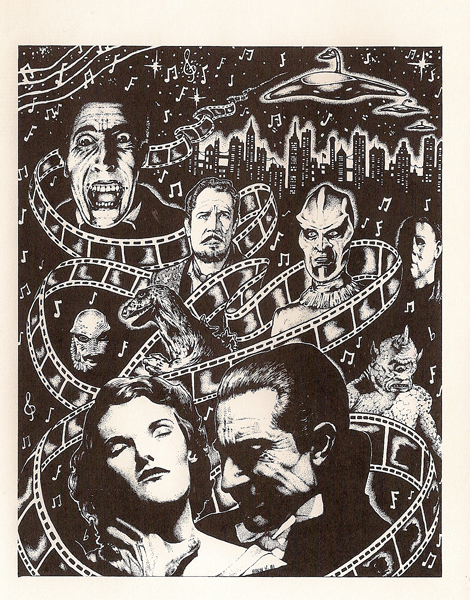An abridged excerpt from Musique Fantastique 2nd Edition, Book 4* (forthcoming)
© Randall D. Larson.
* (book numbering likely to be modified when published.)
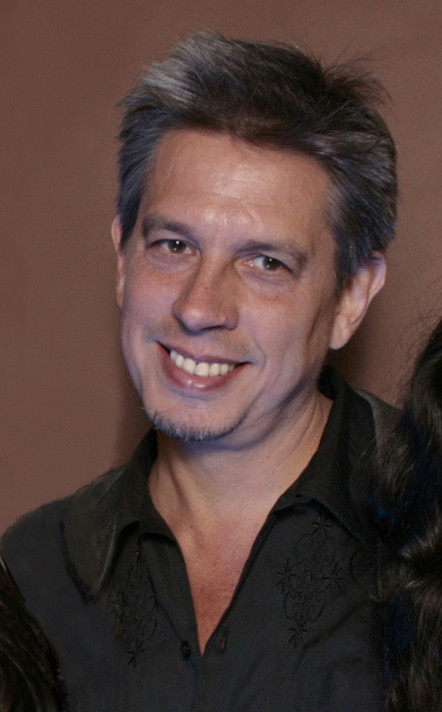
Even in his first efforts at film scoring when he was in his 20s – a pair of films for German director Ulli Lommel, COCAINE COWBOYS (1979) and BLANK GENERATION (1980), both featuring Andy Warhol among their casts – composer Elliott Goldenthal gained a reputation for his off-beat style, and he eventually became known as “the thinking man’s composer” for his unconventional, cerebral style of musical accompaniment for film, theater, and dance, not to mention a growing list of contemporary classical compositions.
In 1990 he brought his classical sensibility to his music with a well-constructed score for Mary Lambert’s PET SEMATARY, based on the Stephen King novel about a mysterious cemetery in the woods that rejuvenates the dead things buried there, albeit in a sinister and twisted way. Goldenthal’s score is primarily a synthesizer score, backed with the Orchestra of St. Luke’s and the Zarathustra Boys Chorus, strikingly well-orchestrated into a breathy harmonic structure that both fits the creepy story and demonstrates some of the avant-garde techniques that the composer would become recognized for.
“I wanted to combine basically a string orchestra with synthesized sounds,” Goldenthal is quoted by writer John Takis in his notes for an expanded CD release of his PET SEMATARY score. “They’d come a long way with digital synthesis, and it had a way or [enlarging] the scope and the radius of the string orchestra.” [1] That string orchestra, along with a piano, were the only live instruments heard in the score. The composer took as his influences the chromatic string writing of Penderecki and the effectiveness of Bernard Herrmann’s PSYCHO score in “getting under your skin.” [2] Goldenthal’s emphatically spooky synth sonorities, performed by the Orchestra of St. Luke’s, a chamber orchestra in New York, are counterpointed by very dissonant clusters of synthesizer.
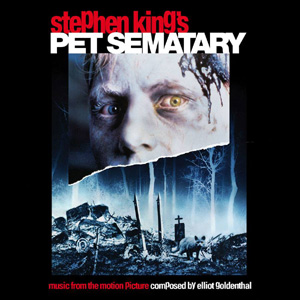
As the film begins, Goldenthal introduces a lullaby-like main theme for boys’ choir over low brass, a tradition reminiscent of Krzystof Komeda’s ROSEMARY’S BABY, Lalo Schifrin’s AMITYVILLE HORROR (1979), Jonathan Elias’ CHILDREN OF THE CORN (1984), and others, capturing the sense of childlike innocence tinged with deadly horror that will be explored in the storyline. This wordless choral motif, sung by the Zarathustra Boys Chorus, will recur in later flashbacks, becoming increasingly more nightmarish. A poignant waltz melody, fronted by piano, is associated with the Creed family, Louis (Dale Midkiff) and his wife Rachel (Denise Crosby), and the quaint country home they have moved into, signifying its bright appearance and the sense of family they hope will endure here. The music – as with the film and its story – is a journey: a walk down a little path into the woods to a kids’ pet cemetery, and on to the Indian burial ground beyond; a journey to death and beyond and back again. Goldenthal’s score laces this journey with initial innocence and melody –– but as the story progresses the excursion becomes darker and eventually becomes a thing of nightmares. The music becomes harsher as the story morphs into pure horror, the gentle piano melody for the Creeds erupts into an aggressive B-section with pounding keyboard, high on reverb and punctuated with the banging of metal on metal and the ringing paroxysm of quivering bell trees.
The score contains a potent mixture of the traditional (spooky string chords building suspense, ominous voicings, etc.) and Goldenthal’s own avant-garde sensibilities that make it a quite strikingly effective film score. The opening lullaby is twisted into something inhuman, overwrought by echoing percussive whispers and muted drum steps as Jud (Fred Gwynne) tells of the first dead boy who came back; the thick, twisted, rubbery distorted violin clusters as young Gage runs out in front of the speeding truck; aggressive, slashing bolts of violins when Louis unearths Gage; a clockwork assemblage of rhythmically clacking percussion and heavy glissandi of harp, and the processed violin screeches for Rachel’s nightmare on her flight home from Chicago; sinewy threads of violins offsetting light raps of piano as Jud searches the house for the brought-back Gage; pounding pianos and shrill, metallic squealing violins when dead boy Gage attacks his father. Goldenthal’s visceral horror music is extraordinarily avant-garde, atonal, grating, and harsh, building a palpable sense of unease as the events unfold. There’s a coda to the story as Rachel returns in the final scene: her poignant piano motif surrounds them as she hugs her husband for one last time at the final fadeout.
A few years later Goldenthal returned to the horror genre when he inherited a significant genre franchise with David Fincher’s ALIEN3 (1992), following in the musical footsteps of Jerry Goldsmith and James Horner, who had scored the first two films in the series. His first mainstream film score, it did much to establish Goldenthal as a major Hollywood composer. He spent a year composing the score, which features boy soprano and choir to evoke the twisted religion postulated in the storyline. Goldenthal recorded the score during the 1992 Los Angeles riots, and said they contributed to the score’s “disturbing nature.” [3]
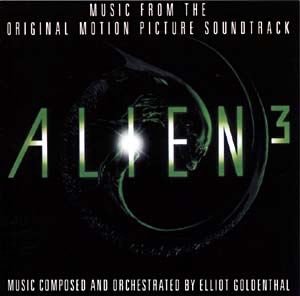
“Elliot Goldenthal’s music for… ALIEN3 couldn’t have been more different from the previous two scores,” said soundtrack album producer Robert Townson, introducing a concert performance of the ALIEN scores in Spain. “His score is the perfect resolution to the trilogy; in the end it is a catharsis, Elliot took a very spiritual approach and created something contemplative and solemn.” [4] Goldenthal’s ALIEN3 score is thoroughly compelling, an unusual composition meshing electronics with complex clusters of brass, spiritualistic voicings, and creative orchestration. The score begins over the main titles with “Agnus Dei” (“Lamb of God; part of the Catholic Mass) sung by a boy soprano – Goldenthal wanted it to refer to the prisoners of Fiorina ‘Fury’ 161 as lambs being led to the slaughter; and it culminates in an adagio as Ripley falls, Christ-like, into the inferno at the film’s end, the music rising triumphantly even as she descends slo-mo into the flames, speaking not so much for her demise as to the victory she has gained by simultaneously destroying the alien fetus harbored within her. ALIEN3 is a coolly nightmarish score, ambient, slightly avant-garde, and very articulate in reflecting the story’s spiritual subtexts even while taking its changes from nuances in character development: “When I write, I write very closely to the character,” he said. “I look at the character’s eyes, and sometimes when a character makes a decision, you look deep into their eyes and you see their acting skill, the decision is made to do this or that [with the music].” [5]
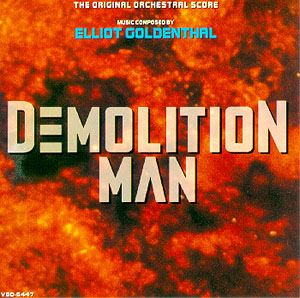
The following year Goldenthal returned to science fiction, although with more of an action thrust than a horror sensibility, with DEMOLITION MAN (1993), in which Sylvester Stallone plays John Spartan, a former cop brought out of suspended animation to pursue an old enemy currently threatening a nonviolent future society. Goldenthal’s score is typically off-beat, often brutal in its uncompromising industrial machinations, comprising a variety of unconventional styles and techniques, utilizing prominent brass and heavy, percussive synth patterns. The music emphasizes the future society and the threat the killer brings to the peaceable civilization, while bolstering the action inherent within its storyline, yet is executed with Goldenthal’s modernistic style and technique. Goldenthal emphasizes the cryogenic process that brings Spartan into the future with a mélange of pizzicato strings, harp, and piano, punctuated by a variety of wood and metallic percussion instruments; elsewhere a melodic, romantic theme for synth strings provides a momentary respite from the banging drive of the action cues. As one reviewer put it, “Goldenthal is never happy just to have a synth rushing along or percussion trouncing the orchestra, but injects some of the most intricate string and brass parts which is several steps above what would be expected…” [6]
DEMOLITION MAN, which won for Goldenthal an ASCAP award for best original score, nicely demonstrated the composer’s action chops, which is no doubt what brought him to the attention of Joel Schumacher, who had taken over the directorial helm of the caped crusader with BATMAN FOREVER (1995) and brought Goldenthal in to assume the film’s musical reins. His score was every bit as dark as Danny Elfman’s musical designs for the previous two Tim Burton films, but his theme was less morose, more complex in its progressive development, but, as Christian Clemmensen has noted, Goldenthal’s theme finishes “with the same heroic, two-note major key rise that Elfman had so famously used.” [7] Whereas Elfman’s score comprises primarily four notes, initially in a very slow cadence, dark and brooding, before opening into a charging, fast-paced variation for brasses over snare with much counterpoint in the strings, Goldenthal’s theme goes through an exciting ten notes in its fast pace rise-and-fall. Elfman’s score, even at its most energetic, maintained a purposeful despondency; Goldenthal’s approach, with its furiously ascending/descending notation, is arguably more exhilarating. “I never heard Danny’s stuff,” Goldenthal admitted in an interview for Soundtrack magazine. “But when you see a big dark, Gothic set like Gotham City, I can imagine how Danny might have been drawn to the same sort of musical connotations, the sort of Wagnerian kind of connotations which have that Gothic, dark quality. It’s not surprisingly to me that people would think there’s a certain similarity.” [8]
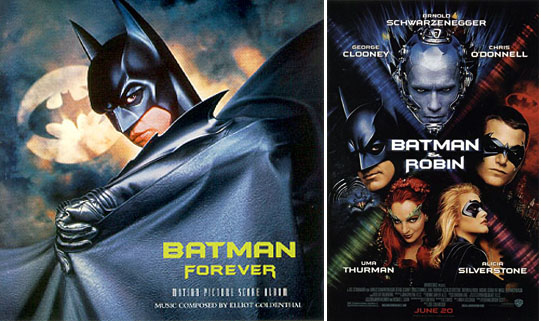
“Originally, director Schumacher petitioned Goldenthal to reuse Elfman’s simple action theme from the previous two outings, but the steadfast composer convinced Schumacher that the dark, Gothic tones would clash horribly with both the new, capricious vision of Gotham City and Goldenthal’s unique brand of music,” noted Andrew Drannon in an online review of the soundtrack. “Luckily, the director remitted… In terms of orchestration, [Goldenthal] noted that complex late 20th century techniques would most likely soar over the heads of a fickle public, so the most innovative approaches were limited to a combination of a typical Romantic orchestral complement and a host of retro jazz instruments, including the unearthly tones of a small choir, a nostalgic 1960’s Moog synthesizer, and the ever-trustworthy Theremin, Hollywood’s traditional harbinger of the unknown.” [9]
The score also features a splendid romantic nocturne, a dark, yearning love theme for strings that drifts like leathery wings above wriggling filigrees of harp and moody trills of oboe. “Compositionally, the score measures up to be a masterstroke, with Goldenthal presenting a seamless amalgam of brilliant Wagnerian pastiche, riotous jazz, and stimulating modernism,” added Drannon. “Yet astoundingly, all of this revolves around a… motif that provides the foundation for at least five different themes, ranging from Batman’s kinetic fanfare to neurotic, film-noirish cacophony to underscore Jim Carrey’s antics.”
Having been successful with BATMAN FOREVER, Goldenthal maintained the same approach for Joel Schumacher’s BATMAN AND ROBIN (1997; in the meantime the two had worked together on the crime thriller, A TIME TO KILL, 1996), expanding his concept to an even stronger mix of anthemic heroism, epic choruses, reverberating atonal sound design, including an arrogant, sultry saxophone theme for Uma Thurman’s Poison Ivy character and a reflective, icy synth motif for Arnold Schwarzenegger’s Mr. Freeze. Bongos and hand drums abound, solidly suggesting a bit of both characters’ themes as Ivy and Freeze team up against the caped crusader and boy wonder, and these frantic drum fills – along with shrieking brasses, fluttering horns, glockenspiel (or xylophone) – interact severely with the Batman theme in the big museum fight scene. An intriguing alternate version of the main title, not used in the film, assumes the rampant big band jazz sensibility of Goldenthal’s later TITUS (1999), and may have been restored for that film due to its disuse in BATMAN AND ROBIN. In these scores, both Goldenthal’s and Elfman’s take on music for the Dark Knight essentially defined superhero angst for the decade, and influenced the even darker approach taken with Batman by Hans Zimmer and James Newton Howard in the following decade.
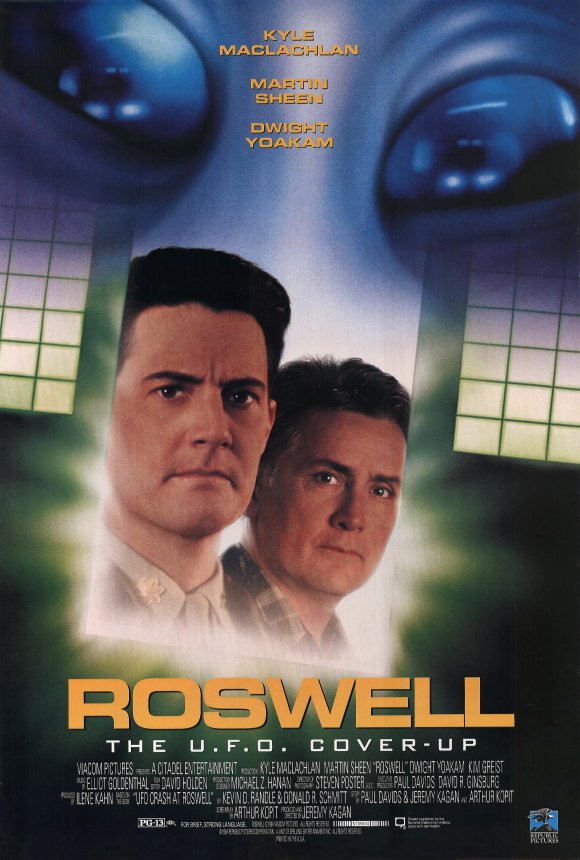
Goldenthal wrote a persuasive score for the 1994 television film ROSWELL, a “docudrama” tracing the conspiratorial history of UFO visitation in and around this New Mexico community. Opening with a montage of military and government representatives testifying about alleged UFO sightings, Goldenthal provided a prominent driving motif for asserting strings, bowing in fluent chords and providing a bustling energy behind the droll depositions of the talking heads. The same motif recurs throughout the film as a motif representing the military and the government, coupled with an innocuous, pretty melody associated with soldier Jesse Marcel (Kyle MacLachlan) and his family as they become immersed into the evidence of extra-terrestrial contact and the deniability of his military bosses. While avoiding science fictionesque music in favor of a workaday businesslike musical atmosphere, Goldenthal underlines the sense of everyday reality evoked by the film – that according to the film’s narrative these events happened in history – and the story is more one of political intrigue than invading aliens. The music provides almost a documentary-like musical backdrop to the film; its claustrophobic, dissonant resonance is provided not for the suspicion of alien encounters but for the government installation itself, and its allegations of covering up those encounters.
The same year Goldenthal received his first Academy Award nomination for his work on Neil Jordan’s film of Anne Rice’s novel, INTERVIEW WITH THE VAMPIRE: THE VAMPIRE CHRONICLES, a first person accounting of the epic life story of the vampire Lestat de Lioncourt (Tom Cruise). Goldenthal’s music is, by turns, Gothic, epic, and romantic in style, setting down a large form tapestry equal to the task of staking out the 200+ year life story of the tempting, undead anti-hero. In many ways, Rice’s book was as much a precursor to the popularity of the vampire-romance novels and films that became huge hits in the late 2000s as was TV’s Angel saga as depicted in BUFFY THE VAMPIRE SLAYER and its spin-off, ANGEL, focusing on a vampire not as a bloodthirsty monster but as an attractive, alluring figure: a tortured soul thirsty for the mothering comfort of a sympathetic mate. Goldenthal’s score paints a similarly engrossing figure, with large, Gothic romantic measures offset against savage, churning orchestral chords that represent the vampire’s less favorable and more fanged facets.
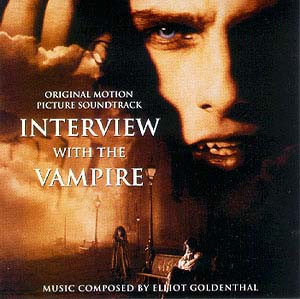
“The music for INTERVIEW WITH THE VAMPIRE conveys the bleak loneliness of the central character mixed with a certain restlessness and an untamed primal element,” wrote one reviewer. [10]
Initially, however, British composer George Fenton had been hired to score INTERVIEW WITH THE VAMPIRE, as he had a long association working with director Jordan (A COMPANY OF WOLVES, HIGH SPIRITS, etc); Fenton had composed his work and was in the midst of recording it when he was released from the production, reportedly by producer David Geffen against Jordan’s wishes, claiming his music was too understated for his liking. Goldenthal, largely due to his work on ALIEN3, was brought in to compose an entirely new score in just three weeks. Fenton’s music went completely unused in the film, although his arrangements of period music throughout the picture remained intact (Chopin’s Nocturne #20 in C# Minor, associated with Claudia, and Haydn’s A flat Adagio e Contabilc, which is the piece played by Lestat in the film). The film concludes with a raucous version of the song “Sympathy for the Devil,” performed by Guns N’ Roses.
Despite the hurried schedule, Goldenthal said that he did have time to experiment and come up with what he and the director felt was the appropriate tone for the score. “Everyone was working 20 hours a day, and I’d play something and the director might or might not like it,” Goldenthal said in an interview at SoundtrackNet. “So it didn’t seem like there would be time to second guess, but there was. I think what happened was a combination of a few things: First off, I locked into a concept pretty fast that the music would go in a chronological development. From arcane sounding music with viola da gamba and boy soprano singing Latin and stuff like that, to the harpsichord, to the modern piano, and the 19th Century orchestra, to sort of the Polish avant-garde, and finally to ‘Symphony for the Devil.’ So, having that kind of ‘up the ladder’ of the chronology of music was something that Neil Jordan and I felt comfortable with. The other thing was that there wasn’t much time for other folks (editors, the studios) to second guess it.” [11]
The score is based on two primary themes, one initially sung by boys’ chorus over high strings (called “Libera Me” – suggesting the vampire’s yearning cry for liberation from his fate), the second a warm melodic theme for full strings (entitled “Born to Darkness”) associated with Louis de Pointe du Lac (Brad Pitt), the despondent vampire who is mentored by the self-assured Lestat. The latter theme musically explores the psychological madness of the vampire, helping Jordon to build a sympathetic characterization that made Louis far more appealing than abhorrent, while the former motif, with or without the choir, underlined the story’s romantic lyricism and the yearning of both Louis and Lestat ultimately to be free of their vampiric curse. These two motifs serve as the stakes upon which the rest of the score is impaled; a variety of dark, muscular, and mysterious sonorities and motifs will circulate around the story, often mixing classical sensibilities with atonal disharmony, but always returning to the ground of one or the other of his primary themes. The score also maintains a rich orchestral sonority with only minor enhancement from electronics; strings and piano are emphasized, embellished in places by harpsichord, glass harmonica, and viola de gamba; for as little time as the composer had to put this score together, it is nonetheless organically cultivated and powerfully persuasive in its effectiveness.
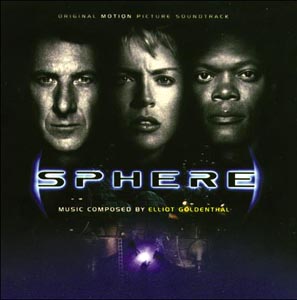
Goldenthal returned to pure science fiction with his score for Barry Levinson’s SPHERE (1998), a film based on the Michael Crichton novel about a spaceship discovered buried beneath century’s worth of coral growth on the ocean floor. Investigators realize that it may have come from the distant future, and that the unusual metal sphere floating inside the ship may be an alien intelligence. Goldenthal’s orchestral score was bolstered by electronics produced by composer Richard Martinez, which enhances the musical coloration and texture throughout the score. The music successfully captured the exotic underwater landscape of the film’s environment through gently stirring orchestral rhythms, especially notable during the main titles and introductory exploration sequences. It’s a familiar technique – the swaying of ocean currents represented by undulating orchestral rhythms – but works very well in establishing the right mood for these scenes. Goldenthal accommodates his more modernistic techniques to accompany a series of attacks manifested by the alien intellect – giant squid, electrical fires, water snakes – and set against the protagonists: ferocious charges of low, growling horns, cyclonic string figures over rolling drums, soft ploddings of processed tubular bells, jarring whaps of metallic gongs, bold clusters of trumpet over plummeting cascades of strings and piano, pierced by shards of violins and raging brasses. The psychological nuances inherent within Goldenthal’s progressive treatment of these attack scenes prefigures the cast’s discovery that they are in fact manifestations of their own fears, evoked by the malevolent intelligence housed within the sphere; the score reserves gentle melody and rhythm for the environment, while the psychological underpinnings of the protagonists and their spherical nemesis are deployed via dissonance, modern progressions of musical texture and form. In the end, when the investigation team finds redemption and escape, the gentle melodic cadence formerly associated with the sea overcomes the discordant influence of the sphere, and both score and story resolve with a delicate bit of piano over synths and echoed drums, growing distant as the menace is averted.
Stepping back into horror territory and rejoining Neil Jordan with IN DREAMS (1999), Goldenthal combined electronics (again produced by Martinez) with symphonics to provide a harsh and inharmonious fragrance for this story of a psychic woman named Claire (Annette Benning) whose mind becomes linked with that of serial killer Vivian Thompson (Robert Downey Jr.) in her dreams. When Claire is locked into a mental institution, the score emphasizes her inability to stop Vivian or protect his victims, one of which may be her own husband, through a claustrophobic sense of entrapment coupled with a piano nocturne that represents both her loneliness and her eventual resignation to follow these dreams to their source. Oppressively dark, layered agitato, mostly cello and violins, exude throughout much of the developing score, building a palpable sense of unease, especially as Claire gets out of the psych ward and locates Vivian, who captures and continues to toy with her. The music delineates the disturbed psychology of Vivian through colorful phrasing and dark, troubling sonorities, as if the composer had peeled back the character’s skull to allow his grotesque inner music to escape.
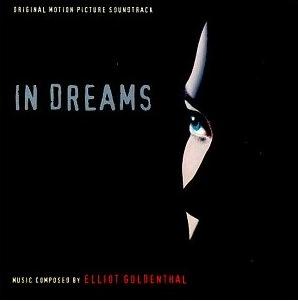
“While his signature orchestral sensibilities remain firmly entrenched, the music’s reliance on dissonant, otherworldly sound effects contributes most to its effective evocation of filmmaker Neil Jordan’s nightmare world,” noted one reviewer. “Not all of Goldenthal’s effects are synthetic, either. Squawking saxophone, abrasive guitar, and dissonant strings further establish a bleakly surreal soundscape rife with mystery and portent.” [12]
During the climax, where Claire escapes from Vivian and is chased by him through the Massachusetts woods, Goldenthal drives forward with shrill, revolving arcs of strings, pylons of tornadic clusters of sound like the rough tree trunks around which the scythe-wielding Vivian pursues Claire, finally adding blares of electric guitar to the mix as police converge. The final chase, in fact, is almost entirely awash with raucous, fuzzy twangs of electric guitars – many deliberately off-key (Goldenthal used a “Guitar Orchestra” named Deaf Elf; the ensemble was also used in his scores for HEAT and TITUS) – over repeated, ascending strings and brass figures that erect a powerful cacophonous energy and add terrifically to the potent suspense of the climax. “The interesting aspect of these deafening and nearly intolerable cues of horror is that they are [so] structurally complicated and fascinating in their astonishingly bizarre constructs,” wrote reviewer Christian Clemmensen. [13] All of this builds to a peak as Vivian catches up to Claire on the top of a large dam; avoiding the rifle fire of airborne police, the two fall into the water below, wherein the music segues into light, lyrical elegy for orchestra and soprano and choir, the fulfillment of Claire’s dream found within the suffocating shroud of frigid water. In an inventive coda, Vivian has survived the fall into the dam and been incarcerated for life; Claire’s Nocturne returns as it is now she who haunts his dreams. The music segues into utter carnage as the killer’s mental demise succumbs under Claire’s posthumous influence and Goldenthal’s score defines his pain in its yowling, slamming flavors as the film cycles to its end.
Goldenthal’s anime score for FINAL FANTASY: THE SPIRITS WITHIN (2001) is a broadly atmospheric score well suited to the cautionary post-apocalyptic CGI science fiction tale based on the Japanese video game series. The film’s computer-based animated realism gave the film’s visual elements a unique hue that Goldenthal recognized when imbuing those characters with emotional resonance via the score. “What I needed to do was establish the more romantic themes, the more tender themes first to make the computer-animated characters appear to be more human,” Goldenthal said. “And then I did more action and more experimental things, and I wanted to make the whole thing sound orchestral as opposed to electronic and futuristic.” [14]
“I wanted to treat the characters’ emotional interactions, for example, as one would treat them in a normal drama, with a lyrical sweeping melody,” Goldenthal wrote in the soundtrack album’s booklet. [15]. Goldenthal introduces that melody on a piano, allowing the commonplace sound of the instrument to contrast with the futuristic, science fiction setting, and thereby “create a more approachable setting for earthbound romantic sentiments.” For the film’s large-scaled action sequences, Goldenthal used “orchestration techniques associated with the late 20th Century Polish avant-garde, as well as my own experiments from ALIEN 3 and 19th-Century Straussian brass and string instrumentation.”
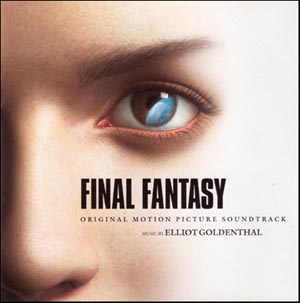
Classically rendered yet given an appropriate forceful dissonance expected in contemporary larger-than-life fantasy epics, the music is very well rendered and beautifully performed by the London Symphony Orchestra. Goldenthal’s main theme is a strong and fast rhythmic cue, vaguely Herrmannesque; its fast pace and aggressive melody instantly arouses interest and starts the adventure off in a very positive note. The score’s intimate humanness is best exemplified when Aki and Edwards share a passionate kiss. Opening softly with piano and synth vocalisms over a shimmering synth tonality that resembles the sound of a glass harp, the cue’s initial furtive lyricism expands gradually, growing in force and tentative tonality, finally emerging into a pretty piano melody over low strings – intimately tender and passionate, one of the composer’s loveliest melodies, poignantly arranged in cadence and power. The cue grows into a fuller rendition of the melody for strings and piano, then bridged by an eerie, sustained synth pattern, merges beautifully into a lilting violin melody embellished by harp, eventually overcome by a harsher down-swelling cello motif. The mixture of the high-end violin melody with the lower descent of cellos creates a stunning counterpoint, generating an emotive mixture of passion and apprehension in the music.
The score’s thematic structure is not so much laden with characters as with situations. “There were leitmotifs but they were mainly about conditions, like the condition of love, the condition of fear, the condition of some sort of spiritual element,” Goldenthal explained. “There’s also a pop song that I wrote at the end… I didn’t want [the filmmakers] to buy a pop song because I wanted the theme to be integrated into the song, so many of the themes are developed slowly and then they sort of culminate in the pop song. That way the song doesn’t sound unusual when it comes out of the movie.” [16] A singer with an extensive range, Lara Fabian was brought in to nail the end title song. The film’s conclusion takes the score’s main theme from a tender flute-and-violins variant through a massive, almost Richard Straussian climactic recapitulation and summation before morphing it something entirely new, as character Capt. Edwards’ spirit is transformed into a new life form.
By grounding his music in familiar melodies and styles, Goldenthal anchors the film in an emotive reality that heightens its power. The music doesn’t fly off into alien dissonances and atonal chaos (although Goldenthal does employ his share of controlled dissonance here from time to time) but sustains itself in melody and a tonal texture that remains accessible and maintains an emotional, human core to the film’s epic and evocative fantasy visualizations.
Notes
1: Elliot Goldenthal, quoted by John Takis, “Dead is Better: The Music of PET SEMATARY,” Notes to Stephen King’s PET SEMATARY soundtrack, limited edition (La-La Land Records, 2013), p. 6.
2: Goldenthal, quoted by Takis, p. 8.
3. Elliot Goldenthal, featurette “Music, Editing and Sound” on Alien3 bonus disc, Alien Quadrilogy box set (Fox, 2003).
4. Robert Townson, spoken introduction to “Alien: A Biomechanical Symphony,” performed at Fimucite 3 (Tenerife International Film Music Festival, 2009). Preserved on Varese Sarabande DVD (issued 2012).
5. Elliot Goldenthal, interviewed by Lukas Kendall, Film Score Monthly #41/42/43 (Jan/Feb/Mar, 1994).
6. Tom Daisch, undated DEMOLITION MAN soundtrack review, posted at www.soundtrack-express.com/osts/demolitionman.htm, accessed 12/4/09.
7. Christian Clemmensen, BATMAN FOREVER soundtrack review, revised 3/4/09, posted at www.filmtracks.com/titles/batman_forever.html, accessed 12/3/09.
8. Elliot Goldenthal, interviewed by Ford A. Thaxton (transcribed and edited by Randall D. Larson), Soundtrack Magazine Vol. 20 #79 (Fall 2001), p.27.
9. Andrew Drannon, BATMAN FOREVER soundtrack review, posted online 2001 at http://scoresheet.tripod.com/Reviews/BatmanForever.html, accessed 12/4/09.
10. Unattributed/undated bio, “Elliot Goldenthal, Sci-Fi Cult Specialist,” posted online at www.mfiles.co.uk/composers/Elliot-Goldenthal.htm, accessed 12/7/09.
11. Elliot Goldenthal, interviewed by Dan Goldwasser, 12/2/02, posted online at www.soundtrack.net/features/article/?id=99, accessed 12/7/09.
12. Uncredited/undated album review, IN DREAMS, posted at http://itunes.apple.com/us/album/in-dreams-original-motion-picture/id117974211, accessed 12/7/09.
13. Christian Clemmensen IN DREAMS soundtrack review, revised 3/27/09, posted online www.filmtracks.com/titles/in_dreams.html, accessed 12/7/09.
14. Elliot Goldenthal, interviewed by Mark Wherry, March 2003, posted online at www.soundonsound.com/sos/Mar03/articles/elliotgoldenthal.asp?print=yes, accessed 12/7/09.
15. Elliot Goldenthal, Composer’s Note on FINAL FANTASY: THE SPIRITS WITHIN soundtrack album (Sony Classical CD, 2001), p.10. All quotes in this paragraph are from this source.
16. Goldenthal, interviewed by Thaxton, p. 26.




